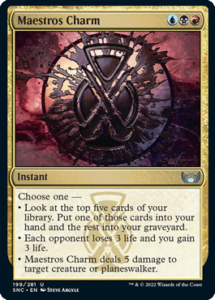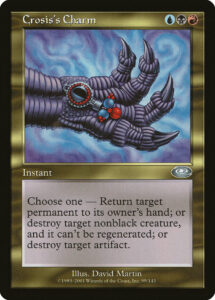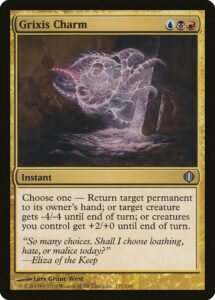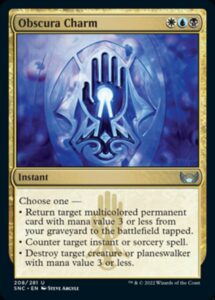Since 1996’s Mirage, Charms have been an indelible part of Magic, even inspiring multiple new cycles like Cryptic Command and Mystic Confluence. These kinds of cards are difficult to design, given how they (almost) always come in five card cycles, they each need three unique modes (with no repetition within the cycle), and they can’t too closely resemble charms that have come before. That’s why we haven’t seen a cycle of monocolor charms since 2007’s Planar Chaos and we’ve rarely seen alternate versions of any multicolor charms—with the notable exception of shard charms like Maestros Charm.
Maestros Charm is the third charm in Grixis colors, following 2008’s Grixis Charm and 2001’s Crosis’s Charm. It’s not surprising to see a new charm in Grixis colors—we’ve gotten tricolor charms in every tricolor set (aside from Ikoria which had the Emergent Ultimatum cycle)—though it’s impressive how different is from its forebears.
For starters, we’ve never seen a charm with an Impulse effect. Sultai Charm cast Catalog; Abzan Charm cast Night’s Whisper, Archmage’s Charm and Esper Charm and cast Divination; Izzet Charm cast Faithless Looting; Treva’s Charm looted only once; Azorius Charm cantripped; and Sapphire Charm slow-cantripped. The closest we’ve gotten is Dimir Charm, but its lack of card draw rendered that mode both awful and not an Impulse. It’s impressive that such a staple effect has never been seen on a Charm despite there already being forty-seven of them (which will soon be fifty-two thanks to Streets of New Capenna).
Overall, I love how Maestros Charm looks. Each mode generates an effect worth ~2.5 mana, so you’re only paying a slight, tricolor premium for the flexibility. The combination of Rending Flame and Forbidden Alchemy covers a lot of bases by removing most threats and digging deep into your deck. As often is the case, one mode is substantially less likely to be used, but a 6 point life swing is just large enough that I can see it squeezing in surprise lethal damage or buying just enough time for a deck to stabilize. But my absolute favorite part of the card? Its beautiful, symmetrical math:
Mode #1: Pick 1 from 5
Mode #2: 3 and 3
Mode #3: Do 5 to 1
That’s just lovely. That little bit of math stapled to some fairly staple effects should do great work in helping people chunk this card’s modes. And all the design work just makes me so excited to see the other four coming down the bend.
It’s incredible looking back twenty-one years at the first multicolor charms. 2001 is the era when Magic began pivoting away from absolutely broken spells and artifacts. And while this effect is definitely restrained compared to cards like Tinker and Dark Ritual, it’s not terribly far off from what we’d see out of a modern charm. Boomerang cost 2 mana, Dark Banishing cost 3*, and Shatter cost 2—a worse rate than the 2.5 we’ll get with Maestros Charm, but not that far off. The overall effect is more powerful than the original Mirage and Visions charms—they combined effects worth less than a mana on a one mana spell, while here, you’re paying a minor premium for access to three effects, each of which you’d be happy to put into your deck. Of course, Crosis’s Charm was the best of its cycle (Darigaaz’s Charm only had 1 mana effects), but it’s amazing seeing two cards separated by over two decades resembling each other so much in power level while two of their three abilities are completely different.
* Technically, you could say that Crosis’s Charm just casts Terror, a two mana spell, and the non-artifact restriction was cut because the Shatter mode covers that base. In fact, I would say that, because that makes all the modes 2 mana effects in 2001.
The odd thing about the design of Crosis’s Charm and the thing we don’t see on modern charms is its minimal modality. All of its modes are removal, with Boomerang overlapping with both Terror and Shatter. Maestros Charm combines three distinct effects, allowing it to serve different functions in different decks and at different stages of the game. Crosis’s Charm is a potent card, but it’s not the toolbox that charms tend to be.
Grixis Charm is an interesting one. While Crosis’s Charm is the best of its cycle, Grixis Charm is almost certainly the worst of its. Sure, Boomerang had become a 3 mana effect by 2008 and Trumpet Blast was also 3 mana, but those aggressively slanted effects don’t really want to go on a color-committing Grixis card. So while Grixis Charm doesn’t demand a mana premium for its flexibility as most charms do, the awkwardness of the package nevertheless presents a hefty cost.
Most awkwardly, Grixis Charm‘s blue mode is identical to Crosis’s Charm‘s. We’d already seen charms repeat modes—Hope Charm and Dromar’s Charm both gained life (though differing amounts), Sapphire Charm and Evolution Charm both granted Flying (identical modes), while Piracy Charm is a color-shifted version of Funeral Charm (effectively identical cards). However, it’s pretty surprising that the first time Magic revisited its multicolor charms, it wholesale duplicated one of their modes on the same-colored charm. I respect that putting Boomerang on Esper Charm would ruin the symmetry of “draw 2” and “discard 2,” while putting it on Bant Charm would recreate Crosis’s Charm‘s redundancy issue. Still, I’d expect exact replication to happen in the third generation of shard charms, not the second. And yet Maestros Charm has three uniquely-configured modes, one of which (the aforementioned Impulse effect) has never been printed on a charm before.
From the two thus far spoiled, a ton of work has gone into Streets of New Capenna’s Charms. They draw lessons from Magic’s 26 years of designing charms, build in newer staple effects that might not have been in vogue or even existed in Planeshift or Alara, and are updated for a modern, slightly more powerful Magic. I’m quite excited to see both the full cycle of charms as well as the whole world of New Capenna. Every single one of those cards will similarly stand astride nearly 30 years of Magic history and be worthy of examination. But, there’s only so much time in the day, so I’ll leave it as an exercise to the reader should they like to delve into any of these other cards’ design ancestry.
And, as always, thanks for reading.
Zachary Barash is a New York City-based game designer and the last commissioner of Team Draft League. He designs for Kingdom Death: Monster, has a Game Design MFA from the NYU Game Center, and does freelance game design. When the stars align, he streams Magic (but the stars align way less often than he’d like).





